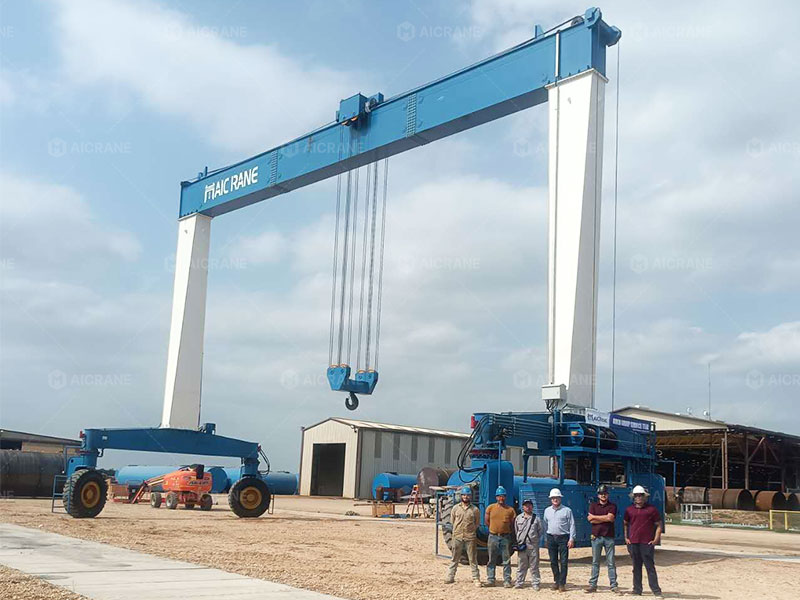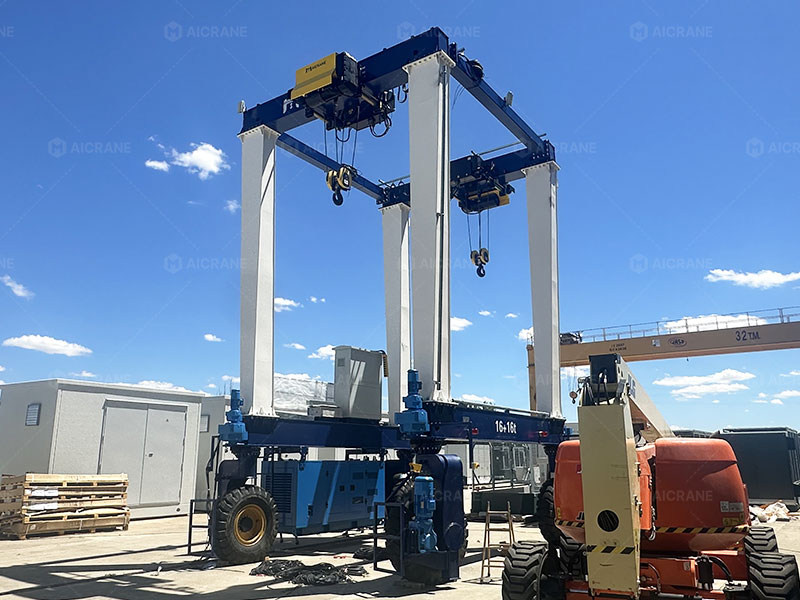Mobile gantry cranes are essential tools in industries such as shipbuilding, construction, logistics, and heavy manufacturing. They provide the flexibility to lift and transport heavy loads within a designated workspace, whether indoors or outdoors. One of the critical decisions in the design and selection of a mobile gantry crane is the choice between hydraulic and electric drive systems. Each drive type has its advantages, limitations, and best-use scenarios.
In this article, we delve into the comparison between hydraulic and electric drive systems for mobile gantry crane, exploring how they operate, their strengths and weaknesses, and what factors should influence your decision when selecting the right system for your operations.

Understanding the Drive Systems
Hydraulic Drive Systems
Hydraulic drive systems operate by transmitting power through pressurized hydraulic fluid. Typically, a diesel engine or electric motor powers a hydraulic pump, which then moves fluid through hoses to actuators or hydraulic motors. These motors generate torque and motion to drive wheels, lift loads, or steer the mobile rubber tire crane.
Key components include:
-
Hydraulic pumps
-
Cylinders and motors
-
Control valves
-
Fluid reservoirs and piping
Hydraulic systems are especially common in heavy-duty lifting scenarios due to their high power density and smooth motion control.
Electric Drive Systems
Electric drive systems utilize electric motors (typically AC or DC) directly connected to the drive wheels and hoisting mechanism. Power is either supplied through batteries (for trackless cranes), cable reels, or hybrid systems. Recent innovations in battery technology and control systems have significantly improved electric drive performance and reliability.
Key components include:
-
Electric motors
-
Motor controllers/inverters
-
Batteries or power supply systems
-
Wiring and sensors
Electric drives are increasingly popular due to their energy efficiency, environmental friendliness, and ease of control.

Key Comparison: Hydraulic vs Electric Drive
| Criteria | Hydraulic Drive | Electric Drive |
|---|---|---|
| Power & Load Capacity | High torque output; better for very heavy loads | Sufficient for medium to heavy loads; limited in ultra-heavy scenarios |
| Speed & Control | Smooth, gradual acceleration; strong under high load | Precise speed and position control; responsive |
| Maintenance | Requires frequent maintenance (fluids, seals, valves) | Lower maintenance; fewer moving parts |
| Energy Efficiency | Lower; hydraulic losses from fluid friction and leaks | Higher; less energy lost during transmission |
| Environmental Impact | Hydraulic oil can leak, requiring spill containment | Clean, no emissions if battery or grid-powered |
| Noise Level | Noisier due to engine and fluid dynamics | Quiet operation, especially indoors |
| Cost | Higher upfront and operating costs | Increasingly cost-effective, especially for smaller cranes |
| Steering & Mobility | Superior in heavy-duty steering (multi-mode steering) | Good in basic and advanced steering, depending on setup |
| Weather Resistance | Performs reliably in harsh environments | Electronics need protection in extreme conditions |
Advantages of Hydraulic Drive in Mobile Gantry Cranes
-
Heavy Load Capability: Hydraulic drives excel in handling massive loads, making them suitable for shipyards, precast concrete handling, and steel fabrication industries.
-
Robust in Harsh Conditions: Hydraulic components can function reliably in extreme temperatures, dirty environments, and under continuous duty cycles.
-
Power-Dense: For a given size, hydraulic motors can deliver significantly more power than electric motors, allowing for more compact and potent gantry crane designs.
-
Flexible Motion Control: Hydraulic systems allow for fine-tuned movement, which is crucial during load positioning or synchronized multi-point lifting.
Disadvantages of Hydraulic Drive
-
Maintenance Intensive: Hydraulic systems require constant attention—fluid levels, pressure testing, and component replacements are regular tasks.
-
Leak Risks: Fluid leaks are both a safety hazard and an environmental concern, especially when working near water bodies.
-
Energy Inefficiency: Heat loss through fluid circulation and pressure drops reduces overall system efficiency.
Advantages of Electric Drive in Mobile Gantry Cranes
-
Energy Efficient: Electric systems convert more input power into useful work, reducing operating costs over time.
-
Eco-Friendly: Ideal for indoor use or environmentally sensitive areas, electric drives produce no exhaust emissions or oil leaks.
-
Lower Operating Costs: Less maintenance, longer component life, and no need for hydraulic fluids make electric drives attractive for many businesses.
-
Advanced Control Integration: Electric drives integrate easily with anti-sway technology, automated positioning, and remote operation features, making them perfect for smart crane systems.
Disadvantages of Electric Drive
-
Battery Limitations: For large gantry crane, current battery technology may not provide enough power or runtime for continuous heavy-duty use without frequent recharging or swapping.
-
Weather Sensitivity: Electronic components can be vulnerable to moisture, corrosion, or extreme heat/cold unless specially protected.
-
Power Supply Dependence: In areas with unstable electricity supply, electric cranes may face operational downtimes unless supported by generators or hybrid systems.
Real-World Applications
When to Choose Hydraulic Drive
-
Shipyards or Marine Applications: Where heavy vessels or modules need to be handled, and weather conditions can be harsh.
-
Large Precast Yards: Moving massive concrete beams or blocks demands high torque and stability.
-
Military or Defense Projects: Reliability and performance under extreme conditions are often non-negotiable.
When to Choose Electric Drive
-
Warehouses or Factories: Indoor environments where quiet, clean, and precise operation is essential.
-
Green Projects: Facilities aiming for carbon neutrality or sustainability certifications benefit from low-emission systems.
-
Maintenance-Friendly Sites: Sites with limited technical personnel benefit from the lower maintenance burden of electric cranes.
Market Trends and Future Outlook
With sustainability and digitalization becoming key trends, the demand for electric drive systems is growing rapidly. Advancements in lithium-ion battery technologies, regenerative braking systems, and AI-powered crane control are making electric drives more capable and competitive—even in traditionally hydraulic-dominated applications.
However, for extremely high-capacity or off-grid lifting operations, hydraulic systems remain indispensable. Many manufacturers are now exploring hybrid systems that combine the strengths of both technologies—for instance, diesel engines driving electric motors with backup hydraulic assist for specific functions.
Some leading mobile gantry crane suppliers now offer:
-
Hybrid diesel-electric mobile boat hoists
-
Battery-powered rubber tyred gantry cranes (RTGs)
-
Hydraulic steering + electric hoisting mobile cranes
This convergence is expected to continue, especially as regulations on emissions and energy consumption become stricter worldwide.
Conclusion
Choosing between a hydraulic and electric drive system for your mobile gantry crane depends on your specific operational needs, environment, and budget.
-
Opt for hydraulic drives when handling extremely heavy loads in harsh environments with high precision and duty cycles.
-
Choose electric drives when clean, quiet, low-maintenance, and energy-efficient solutions are prioritized—especially in indoor or urban environments.
Ultimately, consult with experienced crane manufacturers who can assess your lifting requirements and propose a tailored solution—whether it’s fully electric, hydraulic, or a hybrid system.